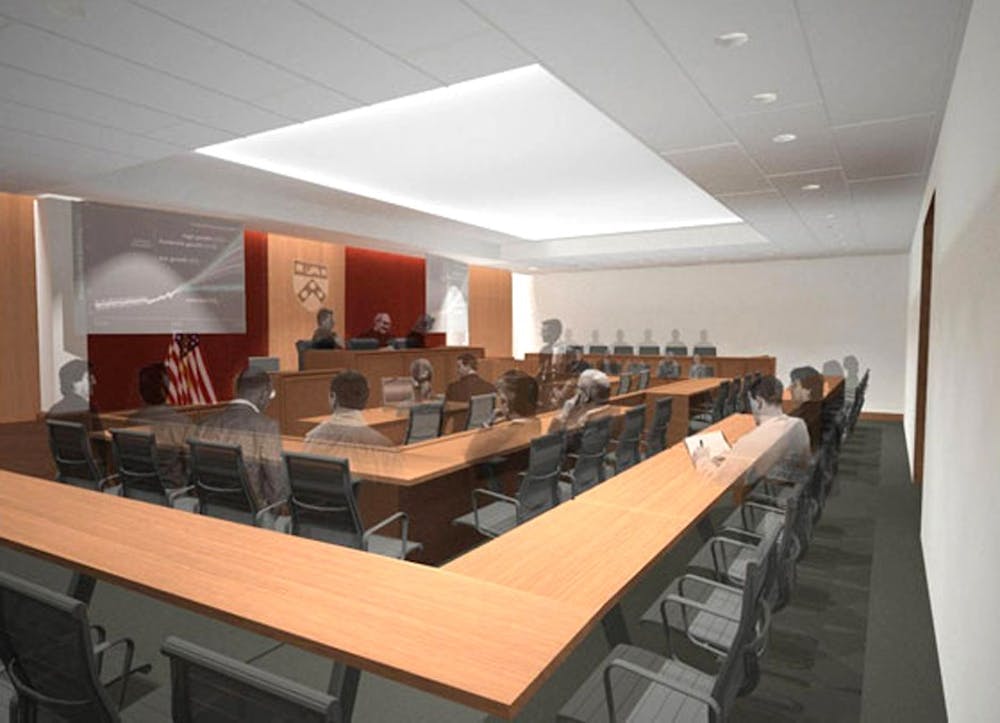
A moot court will be part of the Law School’s Golkin Hall. The new building will also hold classrooms, faculty office space and an auditorium that can seat 340 people. (Courtesy of Jennifer Rizzi)
Credit: Courtesy of Jennifer RizziLaw School students and faculty are eagerly awaiting the opening of a new law school building.
Golkin Hall — which will serve as a home for law students and professors — is slated to open in just over a month on Jan. 9, according to Facilities and Real Estate Services.
The $33.6-million building, which is located on the 3400 block of Sansom Street, will provide Penn Law with more classrooms and faculty office space, an auditorium that seats 350 and a moot courtroom.
“Golkin Hall will complete a ten-year transformation of the Penn Law campus,” Penn Law Dean Michael Fitts said in a statement on the school’s website. “This major expansion in our academic facilities will ensure our continued role as a leader and innovator in legal education.”
The building is replacing Pepper Hall, a one-story office building that was demolished in June 2010.
To complete the project, FRES hired Boston-based architect Kennedy & Violich — which had previously worked on the motion capture studio for the Moore School of Electrical Engineering, which is part of the School of Engineering and Applied Science.
The firm was able to meet Penn Law’s goals and timeframe.
Fitts and Penn Law Vice Dean for Administrative Services Jo-Ann Verrier were looking for a building that would enhance the school’s philosophy of a inter-disciplinary education that focuses on collaboration between students and faculty.
“The beauty of Penn Law’s campus is in four interconnected buildings that resonate with the pedagogical emphasis of the program,” Verrier said.
Golkin, Silverman, Gittis and Tannenbaum Halls — which each belong to Penn Law — are all connected indoors via a walkway that surrounds an outdoor courtyard.
“Our physical space directly impacts our students’ experience: with four buildings surrounding a central courtyard, our campus supports our culture of community and professional engagement,” Fitts wrote in an email. “Much more than just a building, Golkin Hall will promote the collaborative environment that is central to Penn Law’s educational mission.”
Golkin Hall will also add new study rooms, booths and lounges for students.
“Penn Law’s interdisciplinary focus is well reflected in having shared common space for students to work collaboratively and hang out,” said second-year Law student Ted Clement, a representative to the Penn Law Building Committee.
Verrier emphasized that the project was completed “on the fast track” to minimize the effects of any inconveniences caused by the construction.
These inconveniences were not limited to Penn Law faculty and administrators like Fitts and Verrier, who had to be relocated to temporary offices. The construction also reduced pedestrian traffic on Sansom Street and required frequent communication with Kings Court/English College House, located at the end of the block.
“It was a big coordination issue,” FRES Director of the Design and Construction Team Mariette Buchman said.
Buchman said that the construction team managed to keep the sidewalk or a walkway open at all times. However, there were a few instances — including last week when the sidewalk was being paved — in which the street was completely closed for more than 24 hours.
This reduction of pedestrian traffic has hurt some local businesses located across the street on Sansom.
“For us and for our clients it’s been really hard,” Saturn Club Hair Salon stylist Alice de Stefanl said.
In addition to noticing that fewer customers have come in during construction, de Stefanl said the construction team cut down trees across the street, creating a “horrible glare” that makes it harder for her to work.
Penn Law and FRES were aware of some of the problems for local businesses and tried to be accommodating.
“We tried to be as supportive as possible, but I’m sure it wasn’t always pretty,” Verrier said.
FRES principal planner Mark Kocent explained that FRES employees worked with retailers in advance and let them use a parking lot on 34th and Chestnut streets.
However, de Stefanl and co-worker Ananda White said they were never informed about this. They added that they were also not informed exactly when the project would begin.
FRES and Penn Law hope that the construction will help businesses in the long run, since the construction team removed above-ground utilities, streetlights and wooden posts, as well as redoing the sidewalks.
“Everybody was excited about the beautification of the street and putting things underground,” Buchman said. “It’s not something anybody would pay for except Penn.”
“We improved the feel of the pedestrian streetscape,” Verrier said.
“We were all inconvenienced, but hopefully the end result will be a block for the whole campus to enjoy.”
The Daily Pennsylvanian is an independent, student-run newspaper. Please consider making a donation to support the coverage that shapes the University. Your generosity ensures a future of strong journalism at Penn.
DonatePlease note All comments are eligible for publication in The Daily Pennsylvanian.








